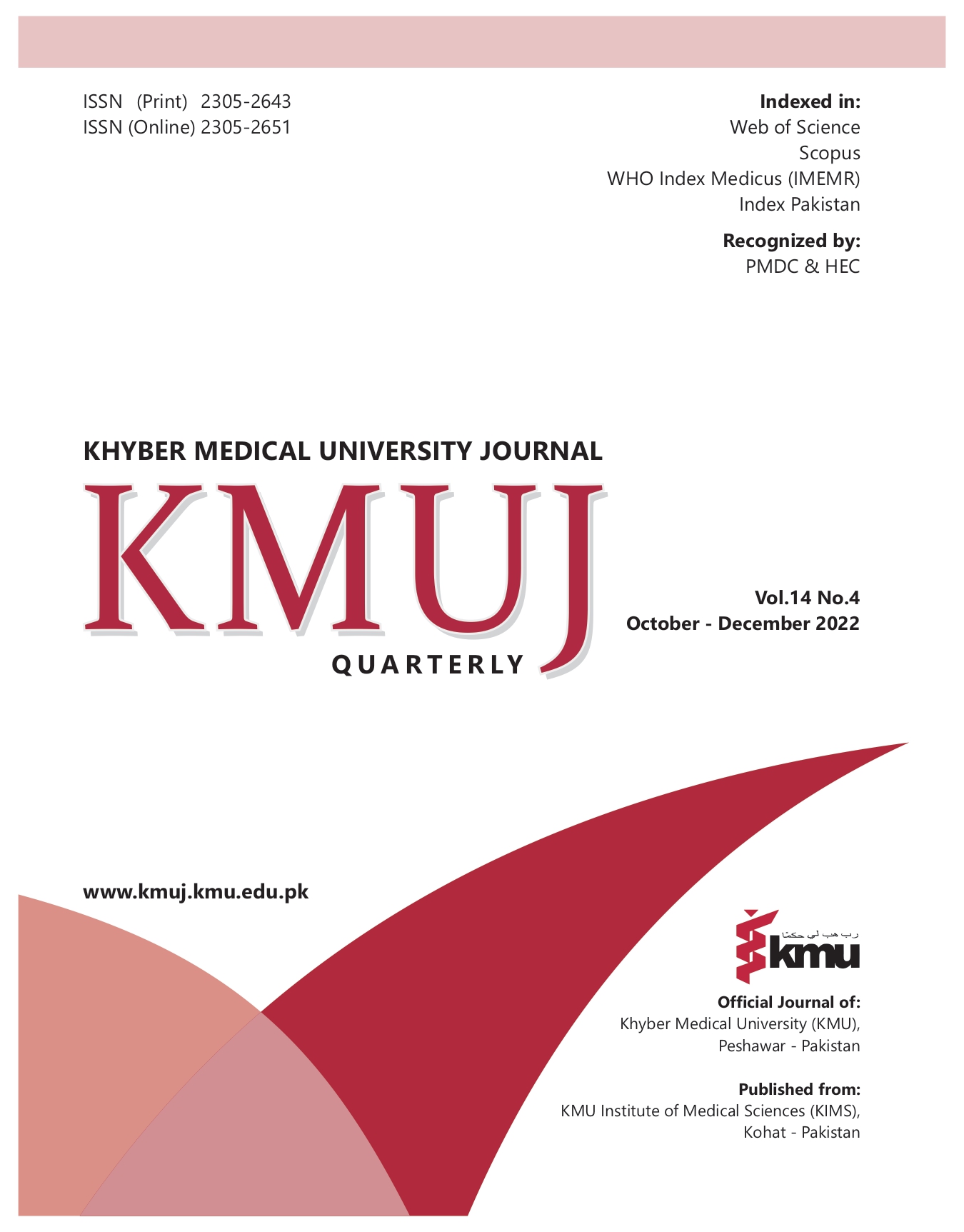CYBERCHONDRIA: ROLE OF POTENTIAL RISK FACTORS
Main Article Content
Abstract
OBJECTIVES: To investigate the relationship between intolerance of uncertainty and cyberchondria and to find out the mediating role of anxiety sensitivity in this relationship.
METHODS: This cross-sectional study was conducted from September 2021 to January 2022 at Bahauddin Zakariyya University, Multan, Pakistan. Participants ranging in age from 18 to 55 years were selected through purposive sampling techniques from different cities of Southern Punjab. Participants who actively use social mediums for online information-seeking of disease-related symptoms were included in the study and participants who confirmed having a physical or psychological health condition were excluded. Cyberchondria, anxiety sensitivity index-3, and intolerance of uncertainty scale were used for measurement. The data were analyzed using structural equation modelling.
RESULTS: Out of 413 participants, 148 (42%) were males and 265 (64.2%) were females. Majority (n=188/413; 45.6%) spent >5 hours on net. Main symptoms searched on internet were psychological (n=61; 14.8%), Physiological (n=175; 42.4%) and both (n=177; 42.8%). Correlation metrics showed that intolerance of uncertainty has a moderate positive correlation with anxiety sensitivity (r=0.59) and cyberchondria (r =-0.41). Similarly, anxiety sensitivity is also positively correlated with cyberchondria (r=0.38). Results further revealed that intolerance of uncertainty has a significant impact on cyberchondria (β=0.48, R2=0.30). Anxiety sensitivity significantly mediates the relationship between intolerance of uncertainty and cyberchondria among the general population (β=0.64, R2=0.41) (β=0.25, R2=0.26).
CONCLUSION: A significant positive relation exists between intolerance of uncertainty, cyberchondria, and anxiety sensitivity. Intolerance of uncertainty significantly impacts cyberchondria. Anxiety sensitivity significantly mediates the relationship between intolerance of uncertainty and cyberchondria.
Article Details
Work published in KMUJ is licensed under a
Creative Commons Attribution 4.0 License
Authors are permitted and encouraged to post their work online (e.g., in institutional repositories or on their website) prior to and during the submission process, as it can lead to productive exchanges, as well as earlier and greater citation of published work.
(e.g., in institutional repositories or on their website) prior to and during the submission process, as it can lead to productive exchanges, as well as earlier and greater citation of published work.
References
Norr AM, Albanese BJ, Oglesby ME, Allan NP, Schmidt NB. Anxiety sensitivity and intolerance of uncertainty as potential risk factors for cyberchondria. J Affect Disord 2015;174:64-9. https://doi.org/10.1016/j.jad.2014.11.023
Akhtar M, Fatima T. Exploring cyberchondria and worry about health among individuals with no diagnosed medical condition. J Pak Med Assoc 2020;70(1):90-5. https://doi.org/10.5455/jpma.8682
Starcevic, V. Cyberchondria: challenges of problematic online searches for health-related information. Psychother Psychosom 2017; 86(3):129-33. https://doi.org/10.1159/000465525
Singh K, Brown RJ. Health-related Internet habits and health anxiety in university students. Anxiety Stress Coping 2014;27(5):542-54. https://doi.org/10.1080/10615806.2014.888061
Baumgartner SE, Hartmann T. The role of health anxiety in online health information search. Cyberpsychol Behav Soc Netw 2011;14(10):613-8. https://doi.org/10.1089/cyber.2010.0425
Fergus TA. Cyberchondria and intolerance of uncertainty: examining when individuals experience health anxiety in response to Internet searches for medical in-formation. Cyberpsychol Behav Soc Netw 2013;6(10):735-9. https://doi.org/10.1089/cyber.2012.0671
Carleton RN. The intolerance of uncertainty construct in the context of anxiety disorders: Theoretical and practical perspectives. Expert Rev Neurother 2012;12(8):937-47. https://doi.org/10.1586/ern.12.82
Dugas MJ, Laugesen N, Bukowski WM. Intolerance of uncertainty, fear of anxiety, and adolescent worry. J Abnorm Child Psychol 2012;40(6):863-70. https://doi.org/10.1007/s10802-012-9611-1
Naragon-Gainey K. Meta-analysis of the relations of anxiety sensitivity to the depressive and anxiety disorders. Psychol Bull 2010;136(1):128. https://doi.org/10.1037/a0018055
McElroy E, Kearney M, Touhey J, Evans J, Cooke Y, Shevlin M. The CSS-12: Development and validation of a short-form version of the cyberchondria severity scale. Cyberpsychol Behav Soc Netw 2019;22(5):330-35. https://doi.org/10.1089/cyber.2018.0624
Taylor S, Zvolensky MJ, Cox BJ, Deacon B, Heimberg RG, Ledley DR, et al. Robust dimensions of anxiety sensitivity: development and initial validation of the Anxiety Sensitivity Index-3. Psychol Assess 2007;19(2):176-88. https://doi.org/10.1037/1040-3590.19.2.176
Carleton RN, Norton MPJ, Asmundson GF. Fearing the unknown: A short version of the intolerance of uncertainty scale. J Anxiety Disord 2007;21(1):105-17. https://doi.org/10.1016/j.janxdis.2006.03.014
O’Bryan E, Stevens K, Bimstein J, Jean A, Mammo L, Tolin D. Intolerance of Uncertainty and Anxiety Symptoms: Examining the Indirect Effect through Anxiety Sensitivity among Adults with Anxiety‑Related Disorders. J Psychopathol Behav Asses 2022;44(2):353-63. https://doi.org/10.1007/s10862-021-09912-0
Çelik E, Biçener E, Bayın U, Uğur E. Mediation Role of Anxiety Sensitivity on the Relationships between Intolerance of Uncertainty and Fear of COVID-19. An de Psicol (Ann Psychol) 2022;389(1):1-6. https://doi.org/10.6018/analesps.469511
